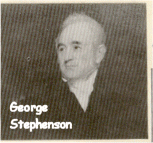|
When was the first train run ?
By the word run a train we mean a vehicle with motive power running
on metal rails.
" The Stockton and Darlington Railway" (1825)
is recognised as the starting of railway age, because they were the first
"Railway" to use a steam locomotive and iron rails to haul a load. It was a load
of 38 carriages laden with passengers and goods ran between Stockton and
Darlington. The railway line was actually commenced in 1821, but it took 4 years
to complete construction.
Prior to this in 1801 Richard Trevithick made the steam carriage and
in 1804 constructed a locomotive to haul a 10-ton load not on the rails but on
the roads.
For other countries the list is as follows:
|
|
France - 1829 ;
USA - 1830 |
Germany
- 1835; Russia 1837 |
Holland &
Italy 1839 ; Spain - 1848 |
|
Now let us see about India.
The core of the pressure for building
railways in India came from London in 1840s. For a century thereafter the basic
policies and ultimate management of the Indian Railways were issued from London.
The British built railways in India in order to intermesh the economies of the
two countries. The building of railways in India brought about unintended as
well as hoped for consequences in economic, political and military front. The
new railways tied the the different parts of India together more closely than
ever before.
Some mention should be made of the role of Indian businessmen played in the
early years. There were Indian merchants , both in Calcutta and Bombay who took
an interest in founding of the railways. The most prominent of these was a
remarkable Bengali merchant Prince Dwarkanath Tagore , grandfather of Nobel
laureate poet Rabindranath Tagore. Dwarkanath's firm Carr, Tagore & Company, is
reported to have offered in 1844, to raise one-third of the capital required for
a railway from Calcutta northwest to the coalfields above Burdwan. After
Dwarkanath's premature death a few tears later the other Indian businessmen
played only a passive role. The conception, promotion and launching of India's
railways were all British. (
Daniel Thorner 1955)
|
|
The Railway Age
dawned in India on 16th. April 1853,
when the first train ran from Bombay to Thana, a distance of 21 miles(33.81 Km.)
For some years before that the idea of building railways in India had taken
concrete shape with the Court of Directors of the East India Company in London.
The East India Company had obtained a foothold in India as a trading company,
but gradually lost most of its privileges it had enjoyed as an instrument of
commerce. It had , however been made responsible for the governance of India
under the supervision of a Court of Directors in London. The final authority lay
, of course , with the British Cabinet, who acted on the advice of its special
Board of \control for Indian Affairs. There was a Governor General at Fort
William in Calcutta, having superintending authority over the administration of
India.
The first proposals for construction of railways in India were presented in 1844
to East India
Company in London by,
(a) East Indian Railway
Company headed by R.McDonald Stephenson, and (b) Great Indian Peninsula Railway
Company.
George
Stephenson the great British Locomotive inventor was one the first Directors of
GIPR and his son Robert Stephenson was appointed as the consulting engineer
based at London.
Both E.I.R.
and G.I.P.R were
incorporated in England for the purpose of constructing railway lines in
Calcutta and Bombay presidencies respectively. Though GIPR
company was formed in 1844. George Stephenson could not see his Locomotives run
on Indian soil as he died in 1848.
Lord Hardinge was the Governor
General of India at this point of time. He considered the proposals from
political, military and commercial point of view and thought that Court Of
Directors of East India Company should
liberally give assistance to private
capitalists, willing to make railways in India
, without waiting for
proof that the construction of railways in India should yield reasonable profit.
The Court of Directors in their suggestion that the first attempt should be made
on a limited scale due to some difficulties, deliberated as under,
1. Periodical rains and
inundations;
2. The continued action of violent winds, and influence of a vertical
sun;
3. The ravages of insects and vermin upon timber and earth work;
4. The destructive effect of spontaneous vegetation of Underwood
upon earth
and
brick work;
5. The unenclosed and unprotected tracts of the country though which
railroads
would pass;
6. The difficulty and expenses of securing the services of competent
and trustworthy engineers.
How do you feel about
these apprehensions about 150 years ago ?

|
 |




